
Perissodactyla is an order of ungulates. The order includes about 17 living species divided into three families: Equidae, Rhinocerotidae (rhinoceroses), and Tapiridae (tapirs). They typically have reduced the weight-bearing toes to three or one of the five original toes, though tapirs retain four toes on their front feet. The nonweight-bearing toes are either present, absent, vestigial, or positioned posteriorly. By contrast, artiodactyls bear most of their weight equally on four or two of the five toes: their third and fourth toes. Another difference between the two is that odd-toed ungulates digest plant cellulose in their intestines, rather than in one or more stomach chambers as even-toed ungulates, with the exception of Suina, do.
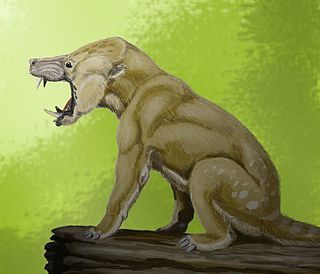
Condylarthra is an informal group – previously considered an order – of extinct placental mammals, known primarily from the Paleocene and Eocene epochs. They are considered early, primitive ungulates. It is now largely considered to be a wastebasket taxon, having served as a dumping ground for classifying ungulates which had not been clearly established as part of either Perissodactyla or Artiodactyla, being composed thus of several unrelated lineages.
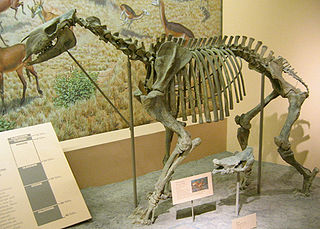
Chalicotheriidae is an extinct family of herbivorous, odd-toed ungulate (perissodactyl) mammals that lived in North America, Eurasia, and Africa from the Middle Eocene until the Early Pleistocene, existing from 48.6 to 1.806 mya. They are often called chalicotheres, a term which is also applied to the broader grouping of Chalicotherioidea. They are noted for their unusual morphology compared to other ungulates, such as their elongated clawed forelimbs. They are thought to have been browsers.
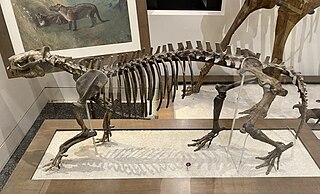
Phenacodus is an extinct genus of mammals from the late Paleocene through middle Eocene, about 55 million years ago. It is one of the earliest and most primitive of the ungulates, typifying the family Phenacodontidae and the order Perissodactyla.
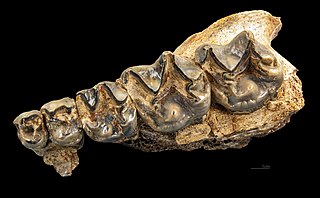
Chalicotherium is a genus of extinct odd-toed ungulates of the order Perissodactyla and family Chalicotheriidae. The genus is known from Europe and Asia, from the Middle Miocene to Late Miocene.

Panperissodactyla is a clade of ungulates containing living order Perissodactyla and all extinct ungulates more closely related to Perissodactyla than to Artiodactyla.
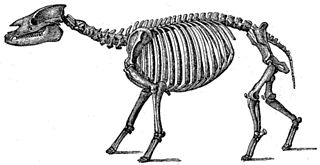
Palaeotheriidae is an extinct family of herbivorous perissodactyl mammals that inhabited Europe, with less abundant remains also known from Asia, from the mid-Eocene to the early Oligocene. They are classified in Equoidea, along with the living family Equidae.
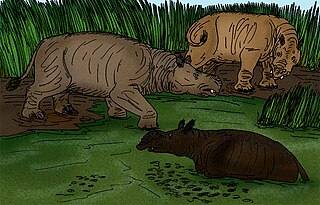
Amynodontidae is a family of extinct perissodactyls related to true rhinoceroses. They are commonly portrayed as semiaquatic hippo-like rhinos but this description only fits members of the Metamynodontini; other groups of amynodonts like the cadurcodontines had more typical ungulate proportions and convergently evolved a tapir-like proboscis.
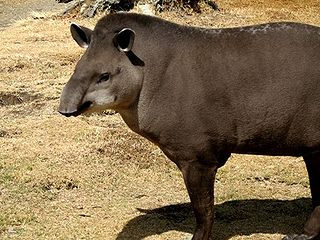
Tapiroidea is a superfamily of perissodactyls which includes the modern tapirs and their extinct relatives. Taxonomically, they are placed in suborder Ceratomorpha along with the rhino superfamily, Rhinocerotoidea.The first members of Tapiroidea appeared during the Early Eocene, 55 million years ago, and were present in North America and Asia during the Eocene. Tapiridae first appeared during the early Oligocene in Europe, and are thought to have originated from the tapiroid family Helaletidae.
The Irdin Manha Formation is a geological formation from the Eocene located in Inner Mongolia, China, a few kilometres south of the Mongolian border.

Phenacodontidae is an extinct family of large herbivorous mammals traditionally placed in the “wastebasket taxon” Condylarthra, which may instead represent early-stage perissodactyls. They lived from the late early Paleocene to early middle Eocene and their fossil remains have been found in North America and Europe. The only unequivocal Asian phenacodontid is Lophocion asiaticus.
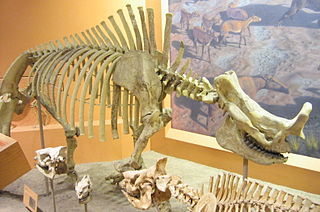
Brontotheriidae is a family of extinct mammals belonging to the order Perissodactyla, the order that includes horses, rhinoceroses, and tapirs. Superficially, they looked rather like rhinos with some developing bony nose horns, and were some of the earliest mammals to have evolved large body sizes. They lived around 56–34 million years ago, until the very close of the Eocene.

Homogalax is an extinct genus of tapir-like odd-toed ungulate. It was described on the basis of several fossil finds from the northwest of the United States, whereby the majority of the remains come from the state of Wyoming. The finds date to the Lower Eocene between 56 and 48 million years ago. In general, Homogalax was very small, only reaching the weight of today's peccaries, with a maximum of 15 kg. Phylogenetic analysis suggests the genus to be a basal member of the clade that includes today's rhinoceros and tapirs. In contrast to these, Homogalax was adapted to fast locomotion.

Altungulata or Pantomesaxonia is a clade (mirorder) of ungulate mammals comprising the perissodactyls, hyracoids, and tethytheres.
Eggysodon is an extinct genus of odd-toed ungulate belong to the rhinoceros-like family Eggysodontidae. It was a small, ground-dwelling browser, and fossils have been found in Oligocene deposits throughout Europe. Eggysodon may have been related to Preaceratherium, and both had tusklike canines and smaller, and fewer, incisors.
Indolophus is an extinct genus of perissodactyl belonging to the clade Tapiromorpha, which includes modern-day tapirs. Fossils have been found in the Early Eocene of Myanmar.
Paracolodon is an extinct genus of tapiroid perissodactyl belonging to the family Helaletidae. Fossils have been found in Mongolia and the Inner Mongolia region of China.
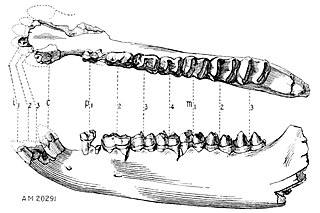
Deperetella is an extinct genus of deperetellid perissodactyls from Middle to Late Eocene of Asia. The genus was defined in 1925 by W. D. Matthew and Walter W. Granger, who named it after French paleontologist Charles Depéret. The type species is Deperetella cristata.
Allacerops is an extinct genus of odd-toed ungulate belong to the rhinoceros-like family Eggysodontidae. It was a small, ground-dwelling browser, and fossils have been found in Oligocene deposits throughout Central and East Asia.
Nanotitanops is an extinct genus of Brontothere from the middle Eocene of China. It contains a single species, N. shanghuangensis. It is known only from isolated teeth, the smallest of any known Brontothere.













